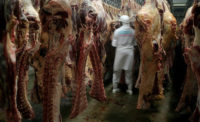On August 6, the U.S. Department of Agriculture’s Food Safety and Inspection Service (FSIS) published a notice in the Federal Register announcing proposed revised Campylobacter performance standards for not-ready-to-eat (NRTE) comminuted chicken and turkey.
Specifically, FSIS proposes a performance standard of no more than five positive Campylobacter results for every 52 tests of 325-gram samples of comminuted poultry. Under this proposed performance standard, an establishment producing comminuted poultry would achieve the performance standard if it has a positive rate of 9.6 percent or less.
FSIS also announced its intent to apply the same three-category system it uses for poultry establishments under the Salmonella performance standard to the Campylobacter performance standard. The criteria for these categories is as follows:
- Category 1: Establishments that have achieved 50 percent or less of the maximum allowable percent positive during the most recently completed 52-week moving window;
- Category 2: Establishments that meet the maximum allowable percent positive but have results greater than 50 percent of the maximum allowable percent positive during the most recently completed 52-week moving window;
- Category 3: Establishments that have exceeded maximum allowable percent positive during the most recently completed 52-week moving window.
The notice also announces FSIS’ intent to propose and request comments on revised Campylobacter performance standards in young chicken and turkey carcasses and in raw chicken parts. These proposals will be issued in the Federal Register after the agency has collected sufficient data.
FSIS is requesting public comments, which are due by Oct. 7. After considering public comments, FSIS will release a subsequent notice in the Federal Register to announce whether it will be finalizing the proposed Campylobacter performance standards.
Change in microbiological analytic methods
FSIS used the 1 mL direct-plating method when it implemented Campylobacter performance standards in NRTE comminuted poultry in 2016. However, on Aug. 27, 2018, the agency issued a Constituent Update announcing the transition to the 30 mL enrichment method test because the enrichment method is several times more sensitive than direct-plating. Upon making this change, FSIS temporarily discontinued Campylobacter performance standard assessments as well as posting of aggregate category results and prevalence estimates pending further study of the results under the enrichment method.
Proposed changes to performance standards
To account for the increase in positive Campylobacter results as a consequence of using the enrichment method, FSIS proposes to modify the performance standards to align them with the agency’s foodborne illness reduction goals. Under the direct-plating method, FSIS’ Campylobacter performance standard was one positive result for every 52 samples, which theoretically yields a 37 percent reduction and a 19 percent reduction in illnesses associated with NRTE comminuted chicken and NRTE comminuted turkey, respectively.
Under FSIS’ proposal, the performance standard associated with enrichment method testing would be five positive tests for every 52 samples. When the agency conducted concurrent testing using the direct-plating and enrichment method, it determined the enrichment method yielded approximately five times more positive results than direct-plating. The agency believes the performance standard of five positive tests for every 52 samples will align with its current illness-reduction goals for the Campylobacter performance standard.
The change in the Campylobacter performance standard will also decrease the minimum number of samples necessary to assess an establishment’s performance. Under FSIS’ proposed changes, the agency will only need to collect a minimum of 11 (instead of 52) samples to assess a NRTE comminuted chicken or turkey processor’s performance under the Campylobacter standard. FSIS anticipates the reduction in the minimum number of samples will result in the agency being able to assess a greater number of otherwise eligible establishments.
After receiving and assessing public comments, FSIS will issue a Federal Register notice announcing whether it will adopt or amend the proposed changes to the Campylobacter performance standard for comminuted chicken and turkey.
Related agency actions
The notice also announces related actions that will take place if the agency adopts the proposed changes to the Campylobacter performance standards. For instance, the agency will use the three-category classification methods and web posting procedures FSIS currently uses to share information about the Salmonella performance standards. The category status posted on the FSIS website would be based on FSIS sample results during the 52-week window ending the last Saturday of the previous month (exclusive of follow-up sampling results).
The notice also states that if the Campylobacter performance standards are finalized, FSIS will post aggregate Campylobacter sampling results relative to categories and prevalence estimates for NRTE comminuted chicken and turkey products. This would be consistent with how the agency publishes Salmonella postings. FSIS will announce its timeline for posting individual establishment category information in the Federal Register notice that announces the final Campylobacter performance standards for NRTE comminuted poultry products. NP




Report Abusive Comment